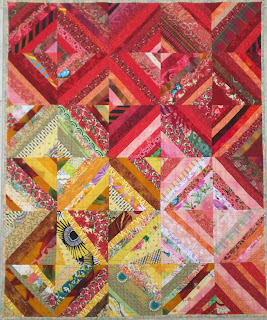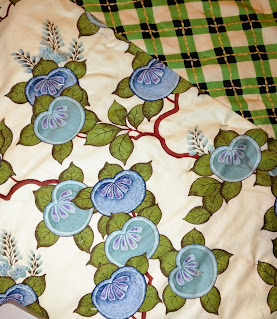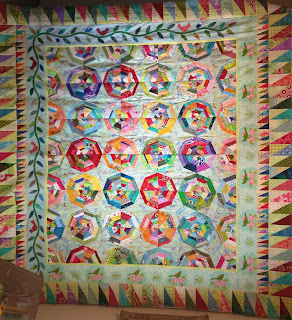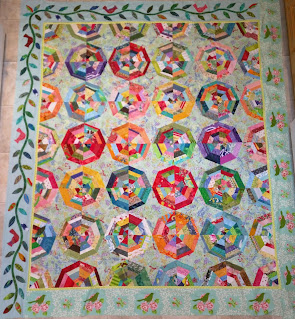Originally I called this a challenge but there are enough challenges of every sort in the world right now. So, let's call it something friendlier and more inclusive: an open invitation. For the first quarter of 2017 we hope you'll explore at least one variation of the Chinese Coin design. If this is your first visit, refer to the inaugural post here.
I've been working on a Chinese Coin quilt that will be a housewarming present to my niece. As usual, it's a learning opportunity. There are many variations but I felt she would prefer something quiet and restrained. Her colors are light blue, yellow, grey, and white. {Not my typical style. Not my personal choice of colors. A good challenge on many levels.}
In keeping with a quieter quilt, I used a striped effect. Each column was originally composed of a single pair of blue, yellow, grey or white fabrics pulled from my stash. When those ran out, I took strips from the scrap bag. For the final column (far left) I snapped this photo to help decide between the two lights. The top light is too beige so I used the cream with yellow poppies on bottom.
 |
| Columns of Chinese Coins ready to arrange |
Once the columns were done I had to work out the order and decide whether or not to add sashing. Here are some of the fabrics I tested. The only one that seemed to add anything to the conversation was a dark grey hand-dyed remnant from Jonathan Shannon. Since that has only enough for one or two sashings, this quilt won't have any.
 |
| Some possible sashing choices for Chinese Coins |
Moving the blue columns further apart while keeping the soft columns on the outside looks better. Although this top was ready to layer and baste, I realized I'd never shown some of the strip sets that were discarded.
 |
| I thought this top was done |
All I did was position a few strip sets on top for a quick comparison. One is the yellow and brown plaid with floral while the other two were still lurking in the scrap bag.
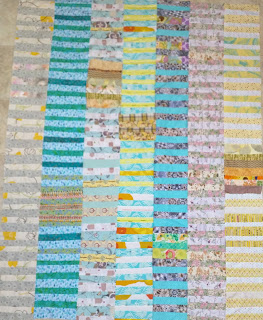 |
| Chinese Coins quilt top with darker sections laid on it |
They are too dark and dull but made me realize I like the way these block sets break up the long columns. Once they were taken off, the quilt looked awkward. Trying to use good art principles, I positioned variations a quarter or third of the way in rather than at the midpoint. But a good plan for a single column makes a problem when several a sewn together. The middle has a "bare" look and the darker blue column on the left and this middle column change colors at the same point.
I also noticed I sewed the right-hand blue column upside down. {If I'd sewed that correctly it would have added more coin change variation.} Those seams were cut freehand so there's no turning it now.
 |
| Replacing a section of one column |
And here's the result. A very minor change: two whites substituted for two yellows in the middle. But it adds a bit of change in the middle of the columns.
 |
| Chinese Coins quilt top, final arrangement |
That middle column still contains only three fabrics: blue, yellow and a Marimekko print. I've only reordered it a bit.
Now I look forward to reading about your projects. Please include your current work, whether or not it's a Chinese Coins project. Everyone is welcome: beginners to experienced quilters. Over the past year we have noticed a wide diversity of construction techniques and specific areas of interest. It's not just a "photo op." Share what you've learned and join our exploration of improvisational and utility quilting.
InLinkz removed because it was hacked.









